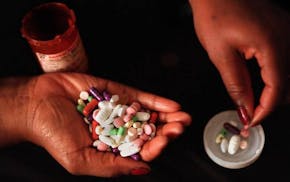Minnesota is entering a bittersweet phase in its fight against HIV: Improved treatments have helped people with the disease live so long that they are dying of other age-related causes.
The state recorded 158 deaths in its HIV population last year, the highest number in at least a decade, but only 32 people died from the disease while the rest were from other causes, according to newly released data from the Minnesota Department of Health. And for the first time half of the state's deaths in its HIV population involved people 60 and older.
"These are my friends that were diagnosed in the '80s and '90s that are facing things like cardiovascular disease, facing things like cancer," said Terri L. Wilder, an HIV and aging policy advocate for SAGE, a nonprofit that serves LGTBQ+ elders.
The longer lifespans are testaments to the antiretroviral drugs that prevent the human immunodeficiency virus (HIV) from replicating and causing fatal complications by destroying the immune system. Many people diagnosed at the start of the AIDS epidemic in the 1980s and early 1990s thought they would die prematurely and never become senior citizens, she said.
The count of Minnesotans living with HIV had been steadily rising, but capped at 9,996 people in 2023, before declining to 9,826 in 2024. The reversal was partly due to the recent uptick in deaths, but health officials said they also did a rigorous check to identify people living with HIV who had moved out of state.
HIV remains a threat in Minnesota, which reported 311 newly discovered infections last year amid outbreaks in the Twin Cities and Duluth, including cases where it was sexually transmitted, among intravenous drug users and among those living in homeless encampments.
The newly discovered infections in 2024 represented a decline from 2023 in Minnesota, but was still the second-highest total in 12 years. HIV is transmitted through direct contact with bodily fluids such as blood and semen, often during sex but also from the sharing of drug needles.
The total included 64 new HIV diagnoses among women. The state also reported 68 people who at the time of their positive HIV tests had already progressed to AIDS, which is diagnosed when the disease has destroyed much of the immune system.
New cases of chlamydia, gonorrhea and syphilis also declined about 9% from 2023 to 2024, suggesting progress in the state's efforts to slow the spread of sexually transmitted diseases (STDs) that had reached record numbers five years ago.
The state health department quietly released the STD and HIV data in mid-April, breaking from an annual tradition in which it publicly announced the data and held webinars to put the trends into context.
The release came as the health department was absorbing $220 million in federal grant cuts announced by President Donald Trump's administration to free up money for tax cuts and other priorities. The department initially responded by issuing layoff notices to 170 people, including infectious disease epidemiologists, but it has since reduced the scope of the layoffs to about 100 workers.
Wilder said a key in the longevity of HIV cases has been the federal Ryan White program, which pays for HIV treatment and support services when people lack insurance. She said she is concerned because Trump's administration is considering multimillion-dollar cuts to that program and has retracted federal funding for STD research. A federal STD surveillance team also was eliminated.
Among the 158 deaths last year, 32 were directly related to HIV — about average in Minnesota over the past decade, according to data the health department provided by request to the Minnesota Star Tribune.
Another 26 people with HIV died from drug overdoses, the data showed, while 95 died from other causes. Some of those deaths had at least indirect links to HIV, though, as studies have found the condition can accelerate aging and increase the risk of stroke, cancer, heart disease and osteoporosis.
Even though they are aging, many people with HIV are still dying prematurely from these other causes because of the toll of drug therapies or the virus itself on their bodies.
Rik Kutcher is an advocate for people with HIV who are aging, and used to manage a support group at the Rainbow Health clinic until it closed last year. The group at one point lost four people, including two to heart problems and one to cancer, said Kutcher, who has dealt with his own health consequences after living with HIV for nearly 40 years.
"The meds we were taking in the early days were really toxic," he said.
Minnesota advocates have been preparing for the aging of the HIV population, holding three listening sessions to learn about their unique mental and physical health needs. The latest session is scheduled Thursday in Rochester. Kutcher teamed up with a University of Minnesota doctor last spring to create a training module for medical students and future clinicians about HIV and its impact on aging.
State lawmakers also have discussed a bill of rights to ensure that people aging with HIV have access to elder-care services and nursing facilities when needed.

More Minnesotans died with HIV last year, but not from HIV

How a small Minnesota medtech company found itself in the FTC's crosshairs

UnitedHealth Group avoids shareholder vote on coverage denial audits in wake of CEO killing
Ramstad: What does 'Made in the USA' mean? Minnesota businesses like Nordic Ware are questioned.

